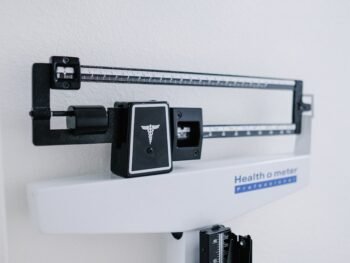Losing weight can be a challenging journey, but with the right strategies and mindset, it is achievable. One popular approach to weight loss is the 3 3 3 rule, which focuses on three key aspects: calorie deficit, portion control, and macronutrient balance. By incorporating these principles into your daily routine, you can create a sustainable and effective plan for shedding those extra pounds.
Key Takeaways
- The 3 3 3 rule for weight loss involves eating three meals a day, each consisting of three hundred calories, and leaving a three-hour gap between meals.
- Calorie deficit is the key to weight loss, which means consuming fewer calories than the body burns.
- Portion control is crucial for weight loss, and using smaller plates and measuring cups can help in this regard.
- Macronutrients, including carbohydrates, proteins, and fats, play a vital role in weight loss, and a balanced diet is essential.
- Exercise is an integral part of the 3 3 3 rule, and incorporating physical activity into daily routine can help in achieving weight loss goals.
Understanding the concept of calorie deficit
Calorie deficit is the foundation of weight loss. It occurs when you consume fewer calories than your body needs to maintain its current weight. To calculate your calorie deficit, you need to determine your basal metabolic rate (BMR), which is the number of calories your body needs to function at rest. From there, you can subtract a certain number of calories to create a deficit.
Creating a calorie deficit is crucial because it forces your body to tap into its fat stores for energy. When you consistently consume fewer calories than you burn, your body will start using stored fat as fuel, leading to weight loss over time. It's important to note that creating too large of a calorie deficit can be counterproductive and may lead to muscle loss or a slowed metabolism. It's recommended to aim for a moderate calorie deficit of around 500-1000 calories per day for safe and sustainable weight loss.
The importance of portion control
Portion control plays a significant role in weight loss because it helps regulate calorie intake. Many people struggle with portion sizes, often consuming more than they realize. By practicing portion control, you can ensure that you are eating appropriate amounts of food without feeling deprived.
To practice portion control, it's helpful to familiarize yourself with recommended serving sizes for different food groups. Measuring cups, food scales, and visual cues can all be useful tools in determining appropriate portions. Additionally, eating slowly and mindfully can help you recognize when you are full and prevent overeating.
Benefits of portion control extend beyond weight loss. It can also improve digestion, reduce the risk of chronic diseases, and promote overall well-being. By being mindful of portion sizes, you can develop a healthier relationship with food and make more informed choices.
The role of macronutrients in weight loss
Macronutrients, also known as macros, are the three main nutrients that provide energy: carbohydrates, proteins, and fats. Balancing these macronutrients is essential for weight loss because they each play unique roles in the body.
Carbohydrates are the body's primary source of energy and should make up a significant portion of your daily calorie intake. However, it's important to choose complex carbohydrates like whole grains, fruits, and vegetables over refined sugars and processed foods.
Proteins are crucial for building and repairing tissues, as well as supporting muscle growth. Including lean sources of protein such as chicken, fish, tofu, or legumes in your meals can help you feel fuller for longer and maintain muscle mass during weight loss.
Fats are often misunderstood but are essential for overall health. Healthy fats like avocados, nuts, and olive oil provide essential fatty acids and help with nutrient absorption. It's important to choose unsaturated fats over saturated or trans fats for optimal health.
Balancing macronutrients is a personal process that may require experimentation to find what works best for you. Consulting with a registered dietitian or nutritionist can provide personalized guidance based on your specific needs and goals.
Incorporating exercise into the 3 3 3 rule
Exercise is a powerful tool for weight loss as it helps burn calories, build muscle, and improve overall fitness. Incorporating regular physical activity into your routine can enhance the effectiveness of the 3 3 3 rule.
There are various types of exercise you can incorporate, including cardiovascular exercises like running, cycling, or swimming, which help burn calories and improve cardiovascular health. Strength training exercises like weightlifting or bodyweight exercises can help build muscle and increase metabolism. Additionally, incorporating activities like yoga or Pilates can improve flexibility and promote overall well-being.
When balancing exercise with the 3 3 3 rule, it's important to consider your energy needs. If you are engaging in intense workouts, you may need to adjust your calorie intake to ensure you have enough fuel for optimal performance. It's also important to listen to your body and give yourself rest days to prevent overtraining and reduce the risk of injury.
Tips for meal planning and preparation

Meal planning and preparation are essential components of successful weight loss. By taking the time to plan and prepare your meals in advance, you can make healthier choices and avoid impulsive decisions that may derail your progress.
Meal planning involves creating a weekly or monthly menu that includes a variety of nutritious meals and snacks. Start by identifying your calorie and macronutrient goals, then choose recipes that align with those goals. Make a shopping list based on the ingredients needed for your planned meals to ensure you have everything on hand.
Meal preparation involves cooking and portioning out meals in advance. This can be done on a weekly or bi-weekly basis, depending on your schedule. Invest in quality food storage containers to keep your meals fresh and easily accessible throughout the week.
Successful meal planning and preparation require some initial effort but can save time and stress in the long run. It also allows you to have more control over the ingredients used in your meals, making it easier to stick to your weight loss goals.
Managing cravings and snacking
Cravings and snacking can be challenging when trying to lose weight, but there are strategies to manage them effectively. Understanding the root causes of cravings can help you develop healthier habits and make better choices.
Cravings can be triggered by various factors, including emotional cues, nutrient deficiencies, or habitual behaviors. By identifying the underlying cause of your cravings, you can find alternative ways to address them. For example, if you tend to crave sweets when stressed, finding healthier ways to manage stress like exercise or meditation can help reduce those cravings.
When it comes to snacking, it's important to choose nutrient-dense options that provide satiety and support your weight loss goals. Opt for snacks that combine protein, healthy fats, and fiber to keep you feeling full and satisfied. Examples include Greek yogurt with berries, a handful of nuts, or sliced vegetables with hummus.
Mindful snacking is also crucial for weight loss success. Take the time to savor each bite and pay attention to your body's hunger and fullness cues. This can help prevent mindless eating and overconsumption of calories.
Tracking progress and adjusting the 3 3 3 rule
Tracking your progress is essential for staying motivated and making adjustments as needed. There are various methods you can use to track your weight loss journey, including weighing yourself regularly, taking body measurements, or using progress photos.
It's important to remember that weight loss is not always linear and can fluctuate due to factors like water retention or muscle gain. Instead of solely relying on the scale, consider other indicators of progress such as how your clothes fit or improvements in energy levels and overall well-being.
If you find that you are not making progress despite following the 3 3 3 rule, it may be necessary to make adjustments. This could involve reassessing your calorie deficit, portion sizes, macronutrient balance, or exercise routine. Consulting with a healthcare professional or registered dietitian can provide valuable guidance in making these adjustments.
Potential challenges and how to overcome them
Weight loss journeys are not without challenges, but with the right strategies, they can be overcome. Some common challenges include plateaus, emotional eating, social situations, and lack of motivation.
Plateaus occur when weight loss stalls despite following the 3 3 3 rule. To overcome plateaus, consider adjusting your calorie deficit, increasing exercise intensity or duration, or incorporating new types of workouts to challenge your body.
Emotional eating can be a significant obstacle for many people. Finding alternative ways to cope with emotions like stress or boredom, such as engaging in hobbies or seeking support from loved ones, can help break the cycle of emotional eating.
Social situations can also pose challenges, as they often involve tempting foods and peer pressure. Planning ahead by bringing your own healthy dish to gatherings or politely declining unhealthy options can help you stay on track.
Lack of motivation is a common hurdle during weight loss journeys. Finding a support system, setting realistic goals, and celebrating small victories along the way can help maintain motivation and keep you focused on your long-term goals.
Sustainable lifestyle changes for long-term weight loss success
Sustainable lifestyle changes are crucial for long-term weight loss success. Instead of viewing weight loss as a temporary fix, it's important to adopt habits that can be maintained for life.
Examples of sustainable lifestyle changes include incorporating regular physical activity into your routine, practicing portion control and mindful eating, prioritizing whole foods over processed options, and finding healthy ways to manage stress and emotions.
It's also important to cultivate a positive mindset and practice self-compassion throughout your weight loss journey. Remember that progress takes time and setbacks are normal. Focus on the overall trend rather than individual fluctuations and celebrate every step forward.
The 3 3 3 rule provides a comprehensive approach to weight loss by focusing on calorie deficit, portion control, macronutrient balance, exercise, meal planning, managing cravings, tracking progress, overcoming challenges, and adopting sustainable lifestyle changes. By incorporating these strategies into your daily routine, you can create a personalized plan for successful and long-term weight loss. Remember that everyone's journey is unique, so it's important to listen to your body and make adjustments as needed. With patience, consistency, and determination, you can achieve your weight loss goals and improve your overall health and well-being.
If you're interested in learning more about the science behind true martial arts training and its impact on the mind and body, check out this insightful article: From Mind to Body: The Science Behind True Martial Arts Training. It delves into the various ways martial arts can benefit your physical and mental well-being, providing a comprehensive understanding of the subject. Additionally, if you've ever wondered whether eating too much fruit can hinder weight loss efforts, this article Can Eating Too Much Fruit Prevent Weight Loss? explores the relationship between fruit consumption and weight management.
FAQs
What is the 3 3 3 rule for weight loss?
The 3 3 3 rule for weight loss is a simple guideline that suggests eating three meals a day, each consisting of three hundred calories, and taking three ten-minute walks throughout the day.
How does the 3 3 3 rule help in weight loss?
The 3 3 3 rule helps in weight loss by controlling calorie intake and increasing physical activity. By limiting the number of calories consumed and increasing physical activity, the body burns more calories than it consumes, leading to weight loss.
Is the 3 3 3 rule effective for weight loss?
The 3 3 3 rule can be effective for weight loss if followed consistently. However, it is important to note that weight loss is a complex process that depends on various factors such as age, gender, metabolism, and lifestyle.
Can the 3 3 3 rule be customized?
Yes, the 3 3 3 rule can be customized according to individual needs and preferences. For example, some people may prefer to have smaller meals more frequently throughout the day, while others may prefer to have larger meals with longer breaks in between.
What are some tips for following the 3 3 3 rule?
Some tips for following the 3 3 3 rule include planning meals in advance, choosing nutrient-dense foods, incorporating physical activity into daily routine, and seeking support from friends and family. It is also important to consult a healthcare professional before starting any weight loss program.










